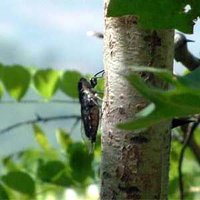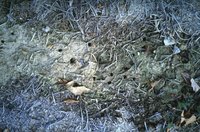Magicicada
|
|
| Periodical cicadas | ||||||||||||||||||
|---|---|---|---|---|---|---|---|---|---|---|---|---|---|---|---|---|---|---|
 A 17-year Periodical cicada | ||||||||||||||||||
| Scientific classification | ||||||||||||||||||
| ||||||||||||||||||
| Species | ||||||||||||||||||
|
See text |
Magicicada is the genus of the 13- and 17- year periodical cicadas of eastern North America. These insects display a unique combination of long life cycles, periodicity, and mass emergences. They sometimes go by the common name "seventeen-year locust", but they are not locusts at all; locusts belong to the order Orthoptera.
| Contents |
Taxonomy
There are seven recognized species. Three species have a 17-year cycle:
Four more species follow a 13-year cycle:
- M. neotredecim (Marshall and Cooley, 2000)
- M. tredecim (Walsh and Riley, 1868)
- M. tredecassini (Alexander and Moore, 1962)
- M. tredecula (Alexander and Moore, 1962)
Generally, the 17-year cicadas are distributed more in the northern states of the eastern United States, while the 13-year cicadas occur in the southern states.
Description
Periodical cicadas are slightly smaller than other, annual cicadas. Imagines have a size of 2.5 to 3 cm (1 to 1.2 inches). They are black, with red eyes and yellow or orange stripes on the underside. The wings are translucent and have orange veins.
They are harmless animals; they neither bite nor sting. They are not poisonous, and there is no evidence that they transmit diseases. They generally do not pose a threat to vegetation, but young plants may be damaged by excessive feeding or egg laying. It is thus advised not to plant new trees or shrubs just before an emergence of the periodical cicadas. Mature plants usually do not suffer lasting damage even by a mass-emergence.
Broods
Periodical cicadas are grouped into thirty broods, based on the year they emerge. Broods are numbered using Roman numerals; broods I–XVII are the seventeen-year cicadas, while broods XVIII–XXX are the thirteen-year cicadas. Some broods are not known to exist, but they are retained in the numbering scheme for convenience.
Brood IX emerged in 2003. Brood X, a seventeen year brood stretching from New York to North Carolina on the East Coast to Illinois and Michigan, emerged in May 2004. Brood X is the largest of the broods of the periodical cicadas. No broods are expected to emerge in 2005 or 2006. The next brood to emerge is Brood XIII—the Northern Illinois Brood. After a seventeen-year hiatus, this brood is scheduled to emerge in 2007.
The next thirteen-year brood to emerge will be Brood XIX in 2011 in Maryland and Virginia.
Brood VII is an isolated population in upstate New York and consists only of M. septendecim. It emerged in 2001, and hence its next emergence will be in 2018.
Life Cycle
The nymphs of the periodical cicadas live underground, at depths of 30 cm (one foot) or more, feeding on the juices of plant roots. They stay immobile and go through five development stages before constructing an exit tunnel in the spring of their 13th or 17th year. These exit tunnels have a diameter of about 1–1.5 cm (½ in.)
The nymphs emerge at an evening when the soil temperature is above 17°C (63 F) and climb to a suitable place on the nearby vegetation to complete their transformation into an adult cicada. They molt one last time and then spend about six days in the leaves waiting for their exoskeleton to harden completely. Just after this final molt, the teneral adults are white, but darken within an hour.
The nymphs emerge in large numbers at about the same time, sometimes more than one million individuals per acre (250/m²). Their mass-emergence is a survival trait called "predator satiation": for the first week after emergence, the periodic cicadas are an easy prey for reptiles, birds, squirrels, cats, and other small and large mammals. The cicadas' survival strategy is simply to overwhelm predators by their sheer numbers, ensuring the survival of most of the individuals and thus of the species.
Adult periodical cicadas live only for a few weeks—by mid-July, they will all be gone. Their short life has one sole purpose: reproduction. The males "sing" a mating song; like other cicadas, they produce loud sounds using their tymbal. Receptive females respond to the calls of conspecific males with timed wing-flicks, which attract the males for mating. The sounds of a "chorus"—a group of males—can be deafening and reach 100 dB.
Cicada_egg_slits_20040606_200213_1.jpg
After mating, the male weakens and dies. The female lives a little longer in order to lay eggs: it makes between six and 20 V-shaped slits in the bark of young twigs and deposits up to 600 eggs there. Shortly afterwards, the female also dies. After about six to ten weeks, the eggs hatch and the newborn nymphs drop to the ground, where they burrow and begin another 13 or 17-year cycle.
External links
- Comprehensive web site (http://www.ummz.lsa.umich.edu/magicicada/Periodical/) at the University of Michigan.
- Why a 17-year cycle? (http://www.gsfc.nasa.gov/scienceques2003/20040507.htm)
- Brood maps and years (http://buzz.ifas.ufl.edu/g900a.htm).
- Bibliography (http://insects.ummz.lsa.umich.edu/fauna/Michigan_Cicadas/Periodical/magilit.html).
- Link list (http://www.loc.gov/rr/scitech/selected-internet/cicadas.html).
- Web site tracking the 2004 emergence of brood X (http://www.cicadamania.org/).
- An image of an adult M. septendecim (http://www.duke.edu/~cwcook/pix/cicada5090.jpg).
- A great image gallery (http://homepage.mac.com/dottiesphotos/PhotoAlbum36.html).
- Roar of the Cicada (http://www.npr.org/features/feature.php?wfId=1905553)



